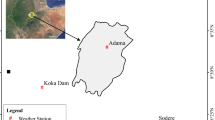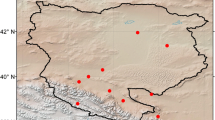Abstract
In this study, the applicability of the statistical downscaling model (SDSM) in modeling five extreme precipitation indices including R10 (no. of days with precipitation ≥10 mm day−1), SDI (simple daily intensity), CDD (maximum number of consecutive dry days), R1d (maximum 1-day precipitation total) and R5d (maximum 5-day precipitation total) in the Yangtze River basin, China was investigated. The investigation mainly includes the calibration and validation of SDSM model on downscaling daily precipitation, the validation of modeling extreme precipitation indices using independent period of the NCEP reanalysis data, and the projection of future regional scenarios of extreme precipitation indices. The results showed that: (1) there existed good relationship between the observed and simulated extreme precipitation indices during validation period of 1991–2000, the amount and the change pattern of extreme precipitation indices could be reasonably simulated by SDSM. (2) Under both scenarios A2 and B2, during the projection period of 2010–2099, the changes of annual mean extreme precipitation indices in the Yangtze River basin would be not obvious in 2020s; while slightly increase in the 2050s; and significant increase in the 2080s as compared to the mean values of the base period. The summer might be the more distinct season with more projected increase of each extreme precipitation indices than in other seasons. And (3) there would be distinctive spatial distribution differences for the change of annual mean extreme precipitation indices in the river basin, but the most of Yangtze River basin would be dominated by the increasing trend.

















Similar content being viewed by others
References
Chen WL (2008) Projection and evaluation of the precipitation extremes indices over China. Magisterial thesis of China. Nanjing, Nanjing University of Information Science & Technology, pp 1–67 (in Chinese with English abstract)
Chen X, Chen YQ (2001) Downscaling of daily precipitation using a stochastic weather generator. J Hydraul Eng 4:47–52 (in Chinese with English abstract)
Chen YD, Chen X, Xu C-Y, Shao Q (2006) Downscaling of daily precipitation with a stochastic weather generator for the subtropical region in South China. Hydrol Earth Syst Sci Discuss 3:1145–1183
Chu JT, Xia J, Xu CY (2008) Suitability Analysis of SDSM Model in the Haihe River Basin. Resour Sci 30(12):1825–1832 (in Chinese with English abstract)
Chu JT, Xia J, Xu CY, Singh VP (2010) Statistical downscaling of daily mean temperature, pan evaporation and precipitation for climate change scenarios in Haihe River, China. Theor Appl Climatol 99:149–161
Dibike YB, Coulibaly P (2005) Hydrologic impact of climate change in the Saguenay watershed: comparison of downscaling methods and hydrologic models. J Hydrol 307:145–163
Fan LJ, Fu CB, Chen DL (2007) Estimation of local temperature change scenarios in North China using statistical downscaling method. Chin J Atmos Sci 31(5):887–897 (in Chinese with English abstract)
Fealy R, Sweeney J (2007) Statistical downscaling of precipitation for a selection of sites in Ireland employing a generalised linear modelling approach. Int J Climatol. doi:10.1002/joc.1506
Fowler HJ, Blenkinsop S, Tebaldi C (2007) Linking climate change modeling to impacts studies: recent advances in downscaling techniques for hydrological modelling. Int J Climatol 27:1547–1578
Fowler HJ, Kilsby CG (2003) A regional frequency analysis of United Kingdom extreme rainfall from 1961–2000. Int J Climatol 23:1313–1334
Frich P, Alexander LV, Della-Marta P, Gleason B, Haylock M, Klein Tank AMG, Peterson T (2002) Observed coherent changes in climatic extremes during the second half of the twentieth century. 19: 193–212
Goswami BN, Venugopal V, Sengupta D, Madhusoodanan MS, Prince Xavier K (2006) Increasing trend of extreme rain events over India in a warming environment. Science 314:1442–1445
Groisman PY, Karl TR, Easterling DR, Knight RW, Jameson PF, Hennessy KJ, Suppiah R, Page CM, Wibig J, Fortuniak K, Razuvaev V, Douglas A, Rorland E, Zhai PM (1999) Changes in probability of heavy precipitation: important indicators of climatic change. Clim Change 42:243–283
Harpham C, Wilby RL (2005) Multi-site downscaling of heavy daily precipitation occurrence and amounts. J Hydrol 312:235–255
Hashmi MZ, Shamseldin AY, Melville BW (2010) Comparison of SDSM and LARS-WG for simulation and downscaling of extreme precipitation events in a watershed. Stoch Environ Res Risk Assess. doi:10.1007/s00477-010-0416-x
Hay LE, Wilby RL, Leavesley GH (2000) A comparison of delta change and downscaled GCM scenarios for three mountainous basins in the United States. J Am Water Resour Assoc 36(2):387–397
Huang JX, Xu ZX, Liu ZF, Zhao FF (2008) Analysis of future climate change in the Taihu Basin using statistical downscaling. Resour Sci 30(12):1811–1817 (in Chinese with English abstract)
Huang J, Zhang JC, Zhang ZX, Xu CY, Wang BL, Yao J (2010) Estimation of future precipitation change in the Yangtze River basin by using statistical downscaling method (SDSM). Stoch Environ Res Risk Assess. doi:10.1007/s00477-010-0441-9
Jiang ZH, Chen WL, Song J, Wang J (2009) Projection and evaluation of t he precipitation extremes indices over China based on seven IPCC AR4 coupled climate models. Chin J Atmos Sci 33(1):109–120 (in Chinese with English abstract)
Khan MS, Coulibaly P, Dibike Y (2006) Uncertainty analysis of statistical downscaling methods. J Hydrol 319:357–382
Li Y, Smith I (2009) A statistical downscaling model for Southern Australia Winter rainfall. J Clim 22:1142–1158
Liao YM, Zhang Q, Chen DL (2004) Precipitation simulation in China with a weather generator. Acta Geogr Sin 59(5):689–698 (in Chinese with English abstract)
Liu ZF, Xu ZX (2009) Trends of daily extreme air temperature in the Wei River Basin in the future. Resour Sci 31(8):1573–1580 (in Chinese with English abstract)
Liu LL, Liu ZF, Xu ZX (2008a) Trends of climate change for the upper-middle reaches of the Yellow River in the 21st century. Adv Clim Chang Res 4(3):167–172 (in Chinese with English abstract)
Liu ZF, Xu ZX, Liu LL, Chen YN (2008b) Temporal trends of future maximum and minimum air temperature in the Tarim River Basin. Arid Land Geography 31(6):822–829 (in Chinese with English abstract)
Masoud H, Philippe G, Taha BMJO, Andre’ S (2008) Automated regression-based statistical downscaling tool. Environ Model Softw 23:813–834
Nguyen VTV, Nguyen TD, Ashkar F (2002) Regional frequency analysis of extreme rainfalls. Water Sci Technol 45:75–81
Nieto JD, Wilby RL (2005) A comparison of statistical downscaling and climate change factor methods: impacts on low flows in the River Thames, United Kingdom. Clim Change 69:245–268
Palmer TN, Räisänen J (2002) Quantifying the risk of extreme seasonal precipitation events in a changing climate. Nature 415:512–514
Qiu B, Jiang JH, Sun ZD, Wang J (2010) Analysis of trends in future temperature and precipitation in the Bosten Lake Bas in based on a statistical downscaling model. Resour Sci 32(6):1133–1140, in Chinese with English abstract
Rong YS, Wang W, Wang P, Wei LS (2010) Downscaling extreme precipitation in Dongjiang River Basin of China based on SDSM. Sciencepaper online in China (in Chinese with English abstract)
Shouraseni SR, Robert CBJR (2004) Trends in extreme daily precipitation indices in India. Int J Climatol 24:457–466
Su BD, Jiang T, Jin WB (2006) Recent trends in observed temperature and precipitation extremes in the Yangtze River basin, China. Theor Appl Climatol 83:139–151
Suppiah R, Hennessy K (1998) Tends in seasonal rainfall, heavy rain-days, and number of dry days in Australia 1910–1990. Int J Climatol 18:1141–1155
Wang YQ, Zhou L (2005) Observed trends in extreme precipitation events in China during 1961–2001 and the associated changes in large-scale circulation. Geophys Res Lett 32:L09707. doi:10.1029/2005GL022574
Wang W, Chen X, Shi P, van Gelder PHAJM (2008a) Detecting changes in extreme precipitation and extreme streamflow in the Dongjiang River basin in southern China. Hydrol Earth Syst Sci 12:207–221
Wang J, Jiang ZH, Yan ML, Zhang JL (2008b) Trends of extreme precipitation indices in the mid-lower Yangtze River valley of China during 1960–2005. Sci Meteorol Sin 28(4):384–388 (in Chinese with English abstract)
Wetterhall F, Halldin S, Xu CY (2007) Seasonality properties of four statistical-downscaling methods in central Sweden. Theor Appl Climatol 87:123–137
Wilby RL, Dawson CW (2007) Using SDSM Version 4.1 SDSM 4.2.2—a decision support tool for the assessment of regional climate change impacts. User Manual, Leicestershire, UK
Wilby RL, Harris I (2006) A framework for assessing uncertainties in climate change impacts: low-flow scenarios. Water Resour Res 42:W02419. doi:10.1029/2005WR004065
Wilby RL, Wigley TML, Conway D, Jones PD, Hewitson BC, Main J, Wilks DS (1998) Statistical downscaling of general circulation model output: a comparison of methods. Water Resour Res 34(11):2995–3008
Wilby RL, Dawson CW, Barrow EM (2002) SDSM—a decision support tool for the assessment of regional climate change impacts. Environ Model Softw 17:147–159
Xu Y, Ding YH, Zhao ZC (2002) Detection and evaluation of effect of human actives on climatic Change in east Asia in recent 30 years. J appl metrol sci 13(5):513–525 (in Chinese with English abstract)
Yuan F, Xie ZH, Ren LH, Huang Q (2005) Hydrological variation in Haihe River Basin due to climate change. J Hydraul Eng 36(3):274–279 (in Chinese with English abstract)
Zhai PM, Ren FM, Zhang Q (1999) Detection of trends in China’s precipitation extremes. Acta Meteorol Sin 57(2):208–216
Zhai PM, Zhang XB, Wan H, Pan XH (2005) Trends in total precipitation and frequency of daily precipitation extremes over China. J Clim 18:1096–1108
Zhang ZX, Klaus F, Jiang T, Zhang JC (2007a) Projection of future precipitation extremes in the Yangtze River basin for 2001–2050. Adv Clim Chang Res 3(6):340–344 (in Chinese with English abstract)
Zhang ZX, Zhang Q, Jiang T (2007b) Changing features of extreme precipitation in the Yangtze River basin during 1961–2002. J Geogr Sci. doi:10.1007/s11442-007-0033-x
Zhang Q, Xu CY, Gemmer M, Chen YD, Liu CL (2008) Changing properties of precipitation concentration in the Pearl River basin, China. Stoch Environ Res Risk Assess. doi:10.1007/s00477-008-0225-7
Zhang ZX, Tao H, Zhang Q, Zhang JC, Forher N, Hörmann G (2010) Moisture budget variations in the Yangtze River Basin, China, and possible associations with large-scale circulation. Stoch Environ Res Risk Assess 24:579–589
Zhao FF, Xu ZX (2007) Comparative analysis on downscaled climate scenarios for headwater catchment of Yellow River using SDS and delta methods. Acta Meteorol Sin 65(4):653–662 (in Chinese with English abstract)
Acknowledgments
This paper was financially supported by Forestry Industry Research special funds for Public Welfare Projects “Study of water resource control function of typical forest vegetation in the region of Yangtze river delta” (No: 201104005–04), fully supported by Key Project of National Science and Technology during the 11th Five-Year Plan (No. 2006BAD03A16), National Nature Science Foundation of China (Grant No: 40801015), State Key Laboratory of Hydrology—Water Resources and Hydraulic Engineering fund from Hohai University (Project No. 2008zd07), Ministry of Water Resources’ special funds for scientific research on public causes, (No. 200901042). We would like to thank the National Climate Centre (NCC) in Beijing for providing valuable climate datasets.
Author information
Authors and Affiliations
Corresponding author
Rights and permissions
About this article
Cite this article
Huang, J., Zhang, J., Zhang, Z. et al. Simulation of extreme precipitation indices in the Yangtze River basin by using statistical downscaling method (SDSM). Theor Appl Climatol 108, 325–343 (2012). https://doi.org/10.1007/s00704-011-0536-3
Received:
Accepted:
Published:
Issue Date:
DOI: https://doi.org/10.1007/s00704-011-0536-3




